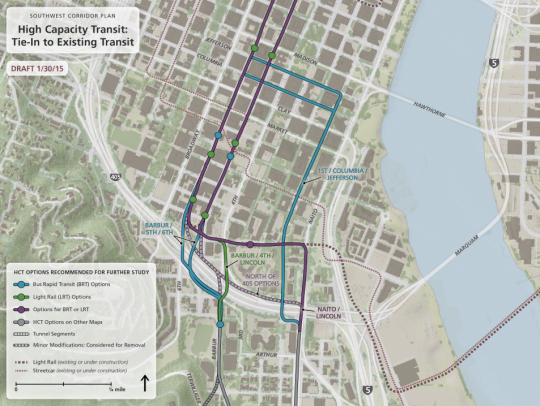
(Maps: Metro)
This post is part of our SW Portland Week.
Interstate Avenue owes its bike lanes to the Yellow Line MAX. The new Tilikum Crossing wouldn’t be standing without the Orange Line.
If the region agrees to build a high-capacity transit line through Southwest Portland to Tigard and Tualatin, major biking improvements — protected bike lanes on Barbur, a full Red Electric Trail between Hillsdale and Alpenrose Dairy, bike lanes and sidewalks on Multnomah Blvd — could be half-funded by federal grants, making them far easier to complete.
“A lot of people think this is just an HCT project, but it’s not,” Metro spokeswoman Noelle Dobson said Monday. Among other modes, she said, “it’s very much about improving bike transportation.”
But which biking improvements will get built will depend on which route a new TriMet bus or rail line would take.
For example, if the transit line runs along, Barbur then the commercial stretch of that street between Terwilliger and the Portland city limits would be largely rebuilt to include complete sidewalks, bike lanes, street trees and crosswalks.
If the line runs along Interstate 5, another option up for discussion, Barbur would only get those improvements within half a mile of the station.
And if the new line were to include a billion-dollar rail tunnel beneath Marquam Hill to OHSU and Hillsdale, a third option, Barbur might not see those major changes at all. But the Red Electric trail to Hillsdale would become much more important instead.
Here are three maps of the leading proposals for where to put a future high-capacity rail or bus line through Southwest Portland, from north to south. First, the south end of downtown Portland’s Transit Mall:
You can see, the circles represent likely transit stop locations and the colors represent different possible routes. Here’s the next step south, between downtown and Hillsdale, with two possible rail tunnel options and a choice between Barbur and Naito through Lair Hill:
And here are the options through Hillsdale and Burlingame:
There you can see the possibilities branch out further. Notice the two different ways to reach Hillsdale, and the possible shift to run along Interstate 5, bypassing much of Barbur. (Here’s a close-up of the Hillsdale area in PDF.)
Advertisement
Finally, let’s look at two maps of Southwest Portland biking and walking improvements that might be associated with these projects. Here’s a set further north:
If you click through to the larger image, you can see numbers associated with each line. They correspond to the items on this list, which includes very rough cost comparisons and notes about which projects would be likely to be associated with different possible routes.
Continuing southwest along the possible project routes, here are some more biking, walking and roadway projects that could be part of a new transit line:
And here’s the list with more detail on the projects pictured.
Metro, the regional agency that is leading the planning of the Southwest Corridor project, is just beginning the process of deciding which of these routes are worth studying in detail. Dobson said Monday that the agency hopes to have a “narrowed set of alignment options and one preferred mode” by April or May of 2016.
Essentially, that means that Metro and its steering committee of mayors and other public executives will decide by next year whether to seriously pursue a Marquam Hill tunnel and/or light rail.
From there, the shortened list of routes would be studied and planned in detail to create a draft environmental impact statement of the project by late 2017. That would lead to a push for local matching funds, followed by a grant application to the Federal Transit Administration if enough local money can be found.
Actual construction wouldn’t take place for another 10 to 20 years, Dobson said. But she noted that based on public response, some projects could be put on a shorter timeline, such as five years.
Even if the new high-capacity transit line is never funded, Dobson said, the projects identified by this process have been identified as important to the area, raising their profile for other grants.
Interested in the Southwest Corridor Plan? We’ll be covering some of the possible work in more detail on Thursday or Friday. In the meantime, you can sign up for updates about the project here or email Dobson directly to share your thoughts: Noelle.Dobson@oregonmetro.gov.
We’ll be here in Southwest all week! And join us Friday afternoon for a BikePortland Get Together and social hour at the Lucky Labrador Public House in Multnomah Village (7675 SW Capitol Hwy) from 4:00 – 6:30pm.





